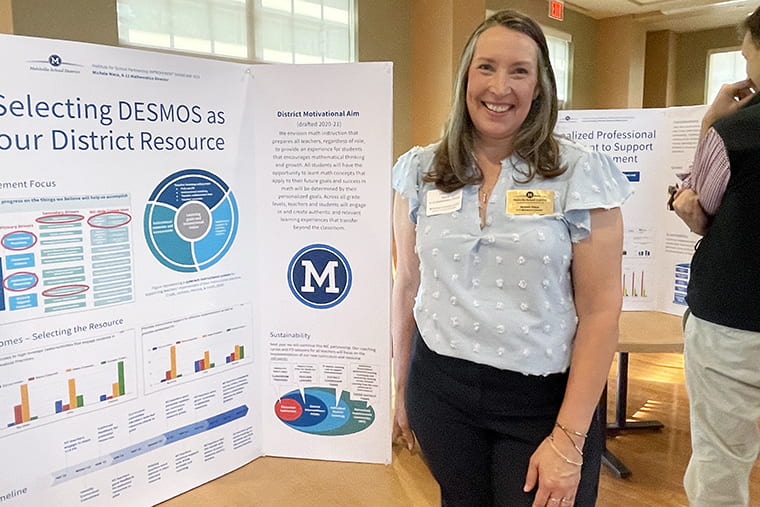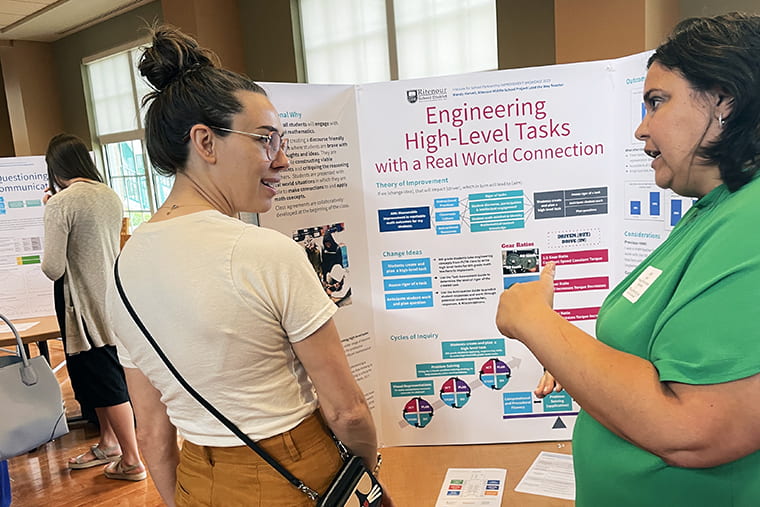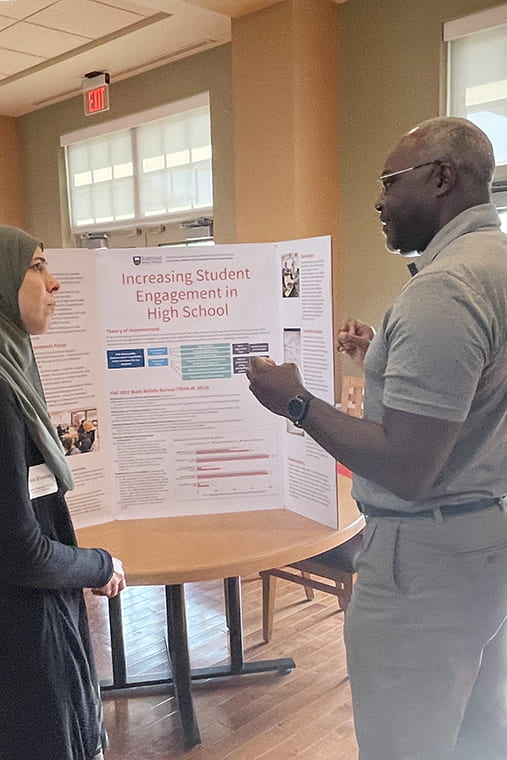Creating environments that invite all students to engage confidently with ambitious mathematical learning is an aim best achieved working in tandem with peer professionals who want the same thing for their students.
After three years of deep exploration into the most impactful ways to implement equitable math instruction, teachers, administrators and math coaches from Mehlville, Maplewood Richmond Heights and Ritenour school districts had the opportunity to share what they’ve learned and what’s working in their classrooms during an Improvement Showcase held May 18 at Washington University.

Teacher leaders and administrators from all three districts, as well as those representing Julia Goldstein Early Childhood Education Center in University City, shared short presentations and posters on a full gamut of research and work they have completed thus far in partnership with instructional specialists and researchers from the Institute for School Partnership at Washington University in St. Louis (ISP) through STEMpact District Immersion (DI) and Math314. Funding has been secured for a fourth year of continued work as participants focus their efforts on implementing equitable math teaching practices throughout their schools and districts for broader impact.
“We know that our district partners–teachers, coaches and administrators are the experts when it comes to their schools, classroom and students,” says ISP Associate Director Rachel Ruggirello. “They bring a wealth of practical knowledge that researchers and other educators need as we learn more about how to navigate very real barriers to improving math learning and achievement. Together, we’re building a growth mindset and capacity that educators need to make teaching math less of a frustrating mystery and more of a discovery process that has paths for all learners.”
More than one path to the math
Math mastery is key to both academic and economic success, but long standing disparities in educational and career opportunities have created a national concern about how we are educating our students in the subject.
Math mastery is key to both academic and economic success, but long standing disparities in educational and career opportunities have created a national concern about how we are educating our students in the subject.
“At the heart of ambitious and equitable math learning is a shift from a long history of teaching math one way,” says ISP Research Director Abbey Loehr. “The traditional model of math instruction upholds the belief that students learn math by following the steps their teacher tells them to follow and repeated practice. This method is very effective for helping students build procedural skills, but assumes that students come to the classroom as blank slates, when in reality, they come with experience and knowledge that is often untapped.”
Loehr says that the primary goal of the DI program is to develop students who can do more than regurgitate facts and follow steps to solve problems.
“Students deserve to develop robust knowledge and mental models of how ideas fit together, be critical thinkers, develop perseverance, explain and justify their reasoning, and experience the joy and wonder of math that many of us didn’t get to experience as students,” adds Loehr.
Getting math through high-level tasks
Teachers, coaches, administrators and students who have been touched by DI work have become very familiar with the phrase high-level task or tasks with high cognitive demand.

Mandy Harvell serves as a Project Lead The Way teacher for Ritenour School District, where she’s also been a math coach and teacher. She’s been immersed in DI work all three years as part of a Networked Improvement Community (NIC) and says a good way to describe a high-level task is by making clear what it’s NOT.
“There is a common misconception that a high-level task is a word problem,” says Harvell. “That’s not it. “High-level tasks have multiple points of entry and paths toward the solution and require thoughtful, thorough planning prior to a lesson that centers student thinking.”
That student thinking unfolds in groups of students who talk, think together and use mathematical representations to share how they are getting to the answer. They embrace mistakes for what they are–just part of the learning process. Teachers using high-level tasks to teach math facilitate discussions by asking questions to further student thinking and discerning when a shift to whole-class discussions. Watch what students have to say about learning math through high-level tasks.

The level of planning, collaboration and exploration required to set the stage for success school and district-wide has included 1:1 and team coaching work, regular convenings and ongoing iteration efforts that have yielded promising outcomes thus far, with more to come as the effort unfolds into a fourth year. Taking a moment to recognize how far the work has progressed and advocating for humanizing, joyful math learning was important and the primary reason for hosting the Improvement Showcase.
“Participating in STEM DI requires a significant commitment of not only time, but personal and professional energy that ultimately benefits students in our region and beyond,” says ISP Associate Director of Strategic Initiatives Nikki Doughty. “It’s been incredible to partner, support and learn from these educators. The work we are doing together to dismantle inequitable structures and challenge the long history of traditional beliefs about how math should be taught and who can do math deserves this level of intention and effort. This work benefits everyone in our region.”
Interested in reading more about STEM DI, equitable math learning and early childhood math? Read these stories:
https://schoolpartnership.wustl.edu/coaching-for-equity/
https://schoolpartnership.wustl.edu/creating-time-and-space-for-collaborative-school-change/
